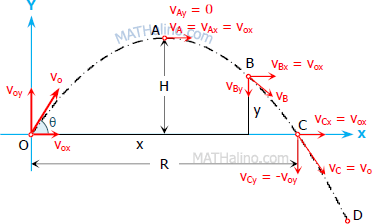Curvilinear Translation (Projectile Motion)
Projectile motion follows a parabolic trajectory. The vertical component of projectile is under constant gravitational acceleration and the horizontal component is at constant velocity. For easy handling, resolve the motion into x and y components and use the formulas in rectilinear translation.
Form the figure below:
$v_{oy} = v_o \, \sin \theta$

At any point B
$x = v_{ox}t$
For the y-component of motion, ay = -g. Notice that the first three formulas that follow are taken from motion with constant acceleration.
$y = v_{oy}t - \frac{1}{2}gt^2$
${v_{By}}^2 = {v_{oy}}^2 - 2gy$
From x = voxt, t = x/vox. Substitute t = x/vox to y = voyt - ½ gt2.
$y = v_{oy}\left( \dfrac{x}{v_{ox}} \right) - \frac{1}{2}g\left( \dfrac{x}{v_{ox}} \right)^2$
$y = v_{oy}\left( \dfrac{x}{v_{ox}} \right) - \frac{1}{2}g\left( \dfrac{x^2}{{v_{ox}}^2} \right)$
$y = v_o \, \sin \theta \left( \dfrac{x}{v_o \, \cos \theta} \right) - \frac{1}{2}g\left[ \dfrac{x^2}{(v_o \, \cos \theta)^2} \right]$
$y = \dfrac{x \, \sin \theta}{\cos \theta} - \dfrac{gx^2}{2{v_o}^2 \, \cos^2 \theta}$
At point A
$t = \dfrac{v_{oy}}{g}$
At point C
$t = \dfrac{2v_{oy}}{g} = \dfrac{2v_o \, \sin \theta}{g}$
Note:
- vy is positive if directed upward and negative if directed downward
- At any point D below the origin O, the sign of y is negative.
- Log in to post comments
